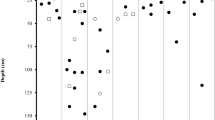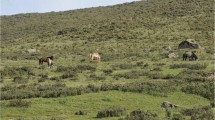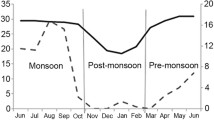Abstract
The Argentine ant is an invasive species that has been introduced worldwide causing devastating effects on entire ecosystems. Control strategies might be focused on slowing its rate of spread to limit its establishment inside yet non-invaded areas. For this, a better knowledge about nest selection is necessary to identify rapidly and accurately nest locations where to apply control measures. Herein, nest site selection by the Argentine ant, nests’ physical characteristics and their longevity were studied in three invaded cork oak secondary forest. Results showed that this species shifts nest locations seasonally to keep appropriate microclimatic conditions, nesting mainly underneath rocks during cold and rainy months and in tree bases during warmer periods. The terrain features at micro-scale (orientation and slope) were found to influence the distribution of the Argentine ant nests beneath rocks. Additionally, artificial nests used as a control tool were tested, finding that their use may be suitable if they are set in appropriate locations and before the ants start migrating to winter aggregations.






Similar content being viewed by others
References
Abril S., Díaz M., Enríquez M.L. and Gómez C. 2012. More and bigger queens: a clue to the invasive success of the Argentine ant (Hymenoptera: Formicidae) in natural habitats. Myrmecol. News 18: 19-24
Abril S., Oliveras J. and Gómez C. 2007. Foraging activity and dietary spectrum of the Argentine ant (Hymenoptera: Formicidae) in invaded natural areas of the northeast Iberian peninsula. Environ. Entomol. 36: 1166-1173
Abril S., Oliveras J. and Gómez C. 2008a. Effect of seasonal dynamics on queen densities of the Argentine ant (Linepithema humile) (Hymenoptera: Formicidae) in an invaded natural area of the NE Iberian Peninsula. Sociobiology 51: 645-654
Abril S., Roura-Pascual N., Oliveras J. and Gómez C. 2009. Assessing the distribution of the Argentine ant using physiological data. Acta Oecol. 35: 739-745
Benois A. 1973. Incidence des facteurs écologiques sur le cycle annuel et l’activité saisonnière de la fourmi d’Argentine, Iridomyrmex humilis Mayr (Hymenoptera, Fomicidae), dans la region d’Antibes. Insect. Soc. 20: 267-295
Brightwell R.J., Labadie P.E. and Silverman J. 2010. Northward expansion of the invasive Linepithema humile (Hymenoptera: Formicidae) in the Eastern United States is constrained by winter soil temperatures. Environ. Entomol. 39: 1659-1665
Brightwell R.J. and Silverman J. 2011. The Argentine ant persists through unfavorable winters via a mutualism facilitated by a native tree. Environ. Entomol. 40: 1019-1026
Choe D.H., Vetter R.S. and Rust M.K. 2010. Development of virtual bait stations to control Argentine ants (Hymenoptera: Formicidae) in environmentally sensitive habitats. J. Econ. Entomol. 103: 1761-1769
Christian C.E. 2001. Consequences of a biological invasion reveal the importance of mutualism for plant communities. Nature 413: 635-639
Cole F.R., Medeiros A.C., Loope L.L. and Zuehlke W.W. 1992. Effects of the Argentine ant on arthropod fauna of Hawaiian high-elevation shrubland. Ecology 73: 1313-1322
Díaz M., Abril S., Enríquez M.L. and Gómez C. 2013. Assessment of the Argentine ant invasion management by means of manual removal of winter nests in mixed cork oak and pine forests. Biol. Invasions, DOI 10.1007/s10530-013-0520-1.
Dornhaus A., Franks N., Hawkins R. and Shere H. 2004. Ants move to improve: colonies of Leptothorax albipennis emigrate whenever they find a superior nest site. Anim. Behav. 67: 959-963
Erickson J.M. 1971. The displacement of native ants species by the introduced Argentine ant Iridomyrmex humilis Mayr. Psyche 12: 256-266
Fellers J.H. and Fellers G.M. 1982. Status and distribution of ants in the Crater District of Haleakala National Park. Pac. Sci. 36: 427-437
Gilg A.W. 1973. A note on slope measurement techniques. Area 5: 114-117
Halley J.D., Burd M. and Wells P. 2005. Excavation and architecture of Argentine ant nests. Insect. Soc. 52: 350-356
Hara A.H. and Hata T.Y. 1992. Ant control on protea in Hawaii. Sci. Hortic. 51: 155-163
Harris R.J., Rees J.S. and Toft R.J. 2002. Trials to eradicate infestations of the Argentine ant, Linepithema humile (Hymenoptera: Formicidae), in New Zealand. In: Proc. 4th Int. Conf. Urban Pests (Jones S.C., Zhai J. and Robinson W.H., Eds), pp 67-74, Charleston, USA.
Hartley S., Krushelnycky P.D. and Lester P.J. 2010. Integrating physiology, population dynamics and climate to make multi-scale predictions for the spread of an invasive insect: The Argentine ant at Haleakala National Park, Hawaii. Ecography 33: 83-94
Hartley S. and Lester P.J. 2003. Temperature-dependent development of the Argentine ant, Linepithema humile (Mayr) (Hymenoptera: Formicidae): a degree-day model with implications for range limits in New Zealand. New Zeal. Entomol. 26: 91-100
Heller N.E. and Gordon D.M. 2006. Seasonal spatial dynamics and causes of nest movement in colonies of the invasive Argentine ant (Linepithema humile). Ecol. Entomol. 31: 499-510
Heller N.E., Ingram K.K. and Gordon D.M. 2008. Nest connectivity and colony structure in unicolonial Argentine ants. Insect. Soc. 55: 397-403
Heller N.E., Sanders N.J. and Gordon D.M. 2006. Linking temporal and spatial scales in the study of an Argentine ant invasion. Biol. Invasions 8: 501-507
Herbers J.M. 1984. Quee-worker conflict and eusocial evolution in a polygynous ant species. Evolution 38: 631-643
Herbers J.M. 1986. Effects of ecological parameters on queen number in Leptothorax longispinosus (Hymenoptera: Formicidae). J. Kansas Entomol. Soc. 59: 675-686
Holway D.A. and Case T.J. 2000. Mechanisms of dispersed central-place foragin in polydomous colonies of the Argentine ant. Anim. Behav. 59: 433-441
Human K.G. and Gordon D.M. 1996. Exploitation and interference competition between the invasive Argentine ant, Linepithema humile, and native ant species. Oecologia 105: 405-412
Human K.G. and Gordon D.M. 1997. Effects of Argentine ants on invertebrate biodiversity in northern California. Conserv. Biol. 11: 1242-1248
Ingram K.K. 2002a. Flexibility in nest density and social structure in invasive populations of the Argentine ant, Linepithema humile. Oecologia 133: 492-500
Ingram K.K. 2002b. Plasticity in queen number and social structure in the invasive Argentine ant (Linepithema humile). Evolution 56: 2008-2016
Jumbam K.R., Jackson S., Terblanche J.S., McGeoch M. and Chown S.L. 2008. Acclimatation effects on critical and lethal thermal limits of workers of the Argentine ant, Linepithema humile. J. Insect Physiol. 54: 1008-1014
Klotz J.H., Rust M.K., Costa H.S., Reierson D.A. and Kido K. 2002. Strategies for controlling Argentine ants (Hymenoptera: Formicidae) with sprays and baits. J. Agr. Urban Entomol. 19: 85-94
Krushelnycky P.D., Joe S.M., Medeiros A.C., Daehler C.C. and Loope L.L. 2005. The role of abiotic conditions in shaping the long-term patterns of a high-elevation Argentine ant invasion. Divers. Distrib. 11: 319-331
Krushelnycky P.D., Lloyd L.L. and Joe S.M. 2004. Limiting spread of a unicolonial invasive insect and characterization of the seasonal patterns of range expansion. Biol. Invasions 6: 47-57
Markin G.P. 1970a. Food distribution within laboratory colonies of the Argentine ant, Iridomyrmex humilis (Mayr). Insect. Soc. 17: 127-158
Markin G.P. 1970b. Foraging behaviour of the Argentine ant in a California citrus grove. J. Econ. Entomol. 63: 740-744
Markin G.P. 1970c. The seasonal life cycle of the Argentine ant, Iridomyrmex humilis (Hymenoptera: Formicidae) in southern California. Ann. Entomol. Soc. Am. 63: 1238-1242
McGlynn T.P. 1999. The worldwide transfer of ants: geographical distribution and ecological invasions. J. Biogeogr. 26: 535-548
Newell W. and Barber T. 1913. The Argentine ant. USDA, Bureau Entomol. B. 122: 1-98
Oliveras J., Bas J.M., Casellas D. and Gómez C. 2005. Numerical dominance of the Argentine ant vs native ants and consequences on soil resource searching in Mediterranean Cork-Oak forests (Hymenoptera: Formicidae). Sociobiology 45: 643-658
Paiva M.R., Way M.J. and Cammell M.E. 1998. A formiga argentina Linepithema (Irydomyrmex) humile (Mayr) - Factores ecológicos restritivos da sua expansão em Portugal continental. Bol. Soc. Port. Entomol. 185: 17-25
Phillips P.A., Bekey R.S. and Goodall G.E. 1987. Argentine ant management in cherimoyas. Calif. Agr. 41: 8-9
Pratt S. 2005. Behavioral mechanisms of collective nest-site choice by the ant Temnothorax curvispinosus. Insect. Soc. 52: 383-392
R Development Core Team. 2011. R: A language and environment for statistical computing. R Development Core Team, R Foundation for Statistical Computing, Vienna, Austria
Robinson W.A. 2008. Selection and sharing of sheltered nest sites by ants (Hymenoptera: Formicidae) in grasslands of the Australian Capital Territory. Aust. J. Entomol. 47: 174-183
Roura-Pascual N., Suarez A.V., Gómez C., Pons P., Touyama Y., Wild A.L. and Peterson A.T. 2004. Geographic potential of Argentine ants (Linepithema humile Mayr) in the face of global climate change. Proc. R. Soc. Lond. B. Biol. 271: 2527-2535
Roura-Pascual N., Suarez A.V., McNyset K., Gómez C., Pons P., Touyama Y., Wild A.L., Gascon F. and Peterson A.T. 2006. Niche differentiation and fine-scale projections for Argentine ants based on remotely sensed data. Ecol. Appl. 16: 1832-1841
Rust M.K., Reierson D. and Klotz J. 2004. Delayed toxicity as a critical factor in the efficacy of aqueous baits for controlling Argentine ants (Hymenoptera: Formicidae) J. Econ. Entomol. 97: 1017-1024
Sanders N.J., Barton K.E. and Gordon D.M. 2001. Long-term dynamics of the distribution of the invasive Argentine ant, Linepithema humile, and native ant taxa in northern California. Oecologia 127: 123-130
Sanders N.J., Gotella N.J., Heller N.E. and Gordon D.M. 2003. Community disassembly by an invasive species. Proc. Natl Acad. Sci. USA 100: 2474-2477
Schilman P.E., Lighton J.R.B. and Holway D.A. 2007. Water balance in the Argentine ant (Linepithema humile) compared with five common native ant species from southern California. Physiol. Entomol. 32: 1-7
Scholes D. and Suarez A.V. 2009. Speed-versus-accuracy trade-offs during nest relocation in Argentine ants (Linepithema humile) and odorous house ants (Tapinoma sessile). Insect. Soc. 56: 413-418
Silverman J., Sorenson C.E. and Waldvogel M.G. 2006. Trap-mulching Argentine ants. J. Econ. Entomol. 99: 1757-1760
Thomas M.L. 2002. Nest site selection and longevity in the ponerine ant Rhytidoponera metallica (Hymenoptera, Formicidae). Insect. Soc. 49: 147-152
Tinaut A., Fernández-Escudero I., Ruano F. and Cerdá X. 1999. The relationship of nest rock dimensions to reproductive success and nest permanence in a high-mountain ant, Proformica longiseta (Hymenoptera: Formicidae). Sociobiology 34: 99-117
Vega S.J. and Rust M.K. 2003. Determining the foraging range and origin of resurgence after treatment or Argentine ant (Hymenoptera: Formicidae) in urban areas. J. Econ. Entomol. 96: 844-849
Way M.J., Cammell M.E., Paiva M.R. and Collingwood C.A. 1997. Distribution and dynamics of the Argentine ant Linepithema (Iridomyrmex) humile (Mayr) in relation to vegetation, soil conditions, topography and native competitor ants in Portugal. Insect. Soc. 44: 415-433
Zuur A.F., Ieno E.N., Walker N.J., Saveliev A.A. and Smith G.M. 2009. Mixed Effects Models and Extensions in Ecology with R. Springer Science Business Media, LLC, New York, NY.
Acknowledgments
Special thanks to Fabrice Gouriveau who provided valuable comments to improve the manuscript. Financial support was provided by the Spanish Ministry of Science and Education, with the associated projects CGL2007-64080-C02/BOS and CGL2010-16451/BOS, and the pre-doctoral grant BES-2008-372 005102 in support to MD. MLE held an FI grant from the European Social Fund and the Autonomous Government of Catalonia.
Author information
Authors and Affiliations
Corresponding author
Rights and permissions
About this article
Cite this article
Enríquez, M.L., Abril, S., Díaz, M. et al. Nest site selection by the Argentine ant and suitability of artificial nests as a control tool. Insect. Soc. 60, 507–516 (2013). https://doi.org/10.1007/s00040-013-0317-3
Received:
Revised:
Accepted:
Published:
Issue Date:
DOI: https://doi.org/10.1007/s00040-013-0317-3




